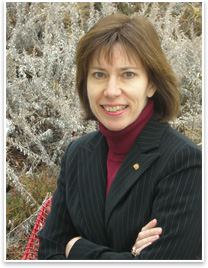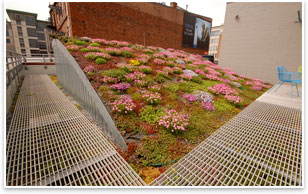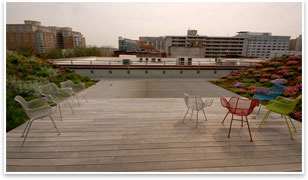 Nancy C. Somerville, Hon. AIA Nancy C. Somerville, Hon. AIA
by Heather Livingston
Contributing Editor
Summary: Nancy Somerville, Hon. AIA, is the executive vice president and CEO of the American Society of Landscape Architects (ASLA). In that capacity, she has led ASLA’s participation as a founding partner in the Sustainable Sites Initiative™. Sustainable Sites, a partnership among ASLA, the Lady Bird Johnson Wildflower Center at the University of Texas at Austin, and the U.S. Botanic Garden, currently is working on creating voluntary national guidelines and performance benchmarks for sustainable land design, construction, and maintenance practices.
The AIA Architect’s Knowledge Resource base can connect you to a profile of the Whitney Water Purification Facility in New Haven, Conn. The design links a public park and the purification facility, enhancing the surrounding wetland environment instead of destroying it through unsustainable practices.
See what else AKR has to offer for your practice.
Images courtesy ASLA.
1) Nancy Somerville, Hon. AIA.
2) The green roof atop ASLA’s headquarters building in Washington, D.C.
View the images.
Education
My training, both at the undergraduate and graduate level, was in English and creative writing. I got an undergraduate degree in English at Princeton University and a master’s in English and creative writing at Stanford.
Hobbies
To the extent I can find time in life between work and raising my 15-year old son, I’m an avid reader and collector of books. If I have time, I like to garden and I love hiking, canoeing, and general outdoor exercise.
Currently reading
I’m just finishing one of Bill Bryson’s books, The Lost Continent. I recently finished another really good book: In Defense of Food, Michael Pollen’s new book.
How did you end up at ASLA?
It really grew out of the years that I spent working at the AIA. I credit the AIA with introducing me to the profession of landscape architecture. I started my professional life as a technical writer. I was hired by David Meeker, FAIA, who was then the AIA EVP, as his writer and program assistant. Meeker had been vice mayor of the City of Indianapolis and deputy assistant secretary at HUD, so his focus was very much on government affairs. By virtue of writing for him and being his program assistant, I started doing a lot in the government affairs area and quickly moved into that specialty within the AIA. By the time I left some 18 years later, I had worked in and been in charge of government affairs, community assistance, membership, component affairs, and continuing education at one time or another, so I’ve had a broad background.
I started with the AIA almost accidentally, but found that I loved and could really engage with the issues of the design professions. It was very easy to be an advocate for good design and community development. One of the things I loved about working at the AIA and now at ASLA is that, as an advocate for the design professions, you have more white hats than you have heads because it’s not about self-interest for the professions. It’s about what’s good for our communities, what creates beautiful, healthy, and sustainable communities. That really fits with my core values.
What is the Sustainable Sites initiative?
This is a really exciting project that we’re about two years through. Our two major partners are the Lady Bird Johnson Wildflower Center at the University of Texas at Austin and the U.S. Botanic Garden. The goal of the project is to develop standards and guidelines that will guide the design, construction, and maintenance of a wide variety of sites. It will basically provide LEED™-like standards for all kinds of design sites. Just like LEED has helped to move the market and increase awareness of green building, the Sustainable Sites initiative is taking that outside the building envelope.
LEED addresses some of the issues and concerns that are involved with the site and the landscape around buildings. They start to get into the hydrology of site, but don’t even touch at all the incredibly critical issue that soils play in the sustainability of the site. Our members saw a need for there to be much more thorough and rigorous attention paid to those aspects. Right now, there’s also no way to apply a metric to a project that doesn’t have a building on it, such as a streetscape, transportation corridor, recreation area, park, zoo, parking lot, or someone’s back yard. Any kind of designed landscape can be more sustainable. The Sustainable Sites initiative will fill that gap.
 I’m happy to say that the U.S. Green Building Council is one of a number of groups that are working with us and participating in it. The USGBC anticipates taking what we have developed and using it to improve the sites aspect of the LEED rating system. We also anticipate having the Sustainable Sites guidelines and benchmarks as a separate rating tool for those projects that aren't covered by LEED or other green building standards so that there is still a way you can assess what you’re doing to move those projects forward to be more sustainable. I’m happy to say that the U.S. Green Building Council is one of a number of groups that are working with us and participating in it. The USGBC anticipates taking what we have developed and using it to improve the sites aspect of the LEED rating system. We also anticipate having the Sustainable Sites guidelines and benchmarks as a separate rating tool for those projects that aren't covered by LEED or other green building standards so that there is still a way you can assess what you’re doing to move those projects forward to be more sustainable.
Can you give me an example of how the Sustainable Sites benchmarks will exceed LEED’s site guidelines?
Soil is a really good example. There’s as much carbon in soil as there is in the atmosphere, so how we treat the soil at a site is critical. If we develop poorly, we can make the environment much worse, so the Sustainable Sites initiative looks at the issues of how to minimize soil compaction because a compacted soil will ruin the hydrology of the site. You won’t get the natural infiltration of water. Even if you green it all over, if the soil has been compacted, it still won’t operate the way it should. It will act like an impervious surface instead of the pervious surface that natural soil and vegetative systems should be. Also important is maintaining the right mix of native soils so that the existing system of biota—all the microorganisms that are part of a natural, healthy soil—can filter the water.
One of the nice things I should mention about the Sustainable Sites initiative is that it is being geared so it can be applied to greenfield, grayfield, or brownfield projects. It can work on everything from how to maintain the healthy systems to how to put healthy systems back in place.
What other organizations besides the USGBC do you envision using Sustainable Sites?
Our goal is to make this information as widely available and in use as possible, so we’re very ecumenical in our approach. We’re happy to hand off to the USGBC and other green building rating systems. We are committed to having it available as a standalone rating tool for the projects that might not be covered by other ratings, but we would like to see it used by federal agencies. We’d like to see public policy makers adopting it the way they have LEED for a wide variety of the public projects, and also we want to have it available to private owners.
One of the things our members told us when we started this was that a lot of their clients’ projects didn’t have significant building components and so couldn’t have qualified for LEED, but their clients would be interested in trying to achieve a sustainability level and were looking for that same seal of approval. We feel that there is definitely a need and a market to rate the greenness of these different kinds of projects, so our goal is to bring in as many organizations now as possible.
We’re really pleased that the AIA has joined Sustainable Sites as a participating organization. We have put out an invitation to quite a number of groups. The AIA has come in and the Urban Land Institute. A number of other groups are coming in. We asked participating organizations to communicate with us, to let their members know to help raise awareness of it, and to provide feedback and input that can help enrich the work that we’re doing, so it’s great to have the AIA as part of it. This is something I think architects should be aware of, and we very much encourage their input and involvement as we go along.
 When do you expect the guidelines to be ready? When do you expect the guidelines to be ready?
They’re available now. We have yet to build the rating system. At this point, we have out in draft the guidelines and the performance benchmarks, and they can be taken as is and used now, but at this point the credits haven’t been weighted. We just completed a public comment process, and we’ll be doing some revisions of those credits, prerequisites, and supporting materials as a result of what we get back from the comment process. Then, our next steps are to publish what will be the final report, which will be coming out in the fall, and start the process of developing a weighted rating system. Following the same sort of timeline and development process that LEED does, we will be soliciting proposals for pilot projects to test it, and then we’ll bring all of that back and see if there are any revisions or adjustments that need to be made based on some real-world experiences using it for a wide variety of projects in a wide variety of regions.
The regionality of it, I would say, is one of the most challenging aspects because obviously the conditions are different depending on region. There are water issues in any part of the country, but the emphasis is very different depending on where you are. There could be flooding, or in the Southwest, it’s water rights. The way the credits have been drafted handles that and also address whether the site is a greenfield, grayfield, or brownfield. There’s very heavy emphasis on the sustainability of developing and using lands that have already been developed and finding ways to regenerate the degraded landscapes. That’s the priority. The bar is set much, much higher for what could be considered a sustainable project when you’re dealing with something that’s truly new development, something on a greenfield site.
Final thoughts?
One point that’s really important I think is that whether you’re talking about sustainability for a single project, a community, or a region, collaboration among the professions to achieve that is absolutely critical. It’s something that has to be done in partnership across the professions. The best examples of sustainability, whether it’s a project that has LEED platinum or it’s something that you would identify as a landscape architectural project, there’s always involvement of a full range of team players. You have to have the team integrated and communicating fully through the length of a project to achieve something that is truly sustainable and that makes the best use of a site, the materials, and everything else that defines a project as sustainable. It’s very exciting to see what that kind of close collaboration is producing for our communities. |



